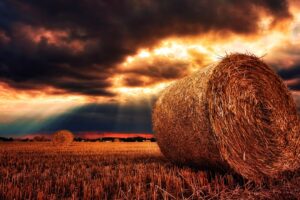By Ryan Shaw
Jesus’ eight parables in Matthew 13 are pictures of conditions (and processes) taking place between the time of Jesus’ first coming and His second coming.
The first four are given by the seaside and focus on the human side of “the Kingdom of God.” These highlight frail human interaction with the Kingdom but not the idea of the eternal, glorious Kingdom where we dwell forever with God.
The next four parables are given among the disciples alone as Jesus is inside the house. These are of a very different nature then those spoken to the large crowd. These focus on the divine perspective of the Kingdom of God and represent internal secrets of the Kingdom for true disciples.
The parable of the Sower (Matthew 13:3-9; 18-23) is the first parable Jesus gives and provides an interpretation for. It forms an introduction and foundation for the subsequent seven parables in chapter 13. To rightly interpret and apply the others, we need to grasp this one clearly.
The concept of a sower sowing seed was so common that all would have immediately understood the significance. However, parables reveal hidden truth (mysteries) so the meaning behind the symbols requires asking the Holy Spirit to give further clarity and understanding.
Our suggested interpretation of this parable is different than often heard.
The general understanding has been the sower is Jesus and those who preach the Word of God. The seed is the Word of God sown into humanity (soils) who respond to it in different ways depending upon their hearts, circumstances and present concerns. This interpretation, however, appears to disagree with Jesus’ own explanation.
Jesus explains the sowing of seed is not the Word sown into the heart of people but the sowing of a believer into a certain generation with the gospel of the Kingdom. It is not truth being sown, but believers.
We find here the method of Jesus’ work globally of sowing sons and daughters of the Kingdom into the world.
To the seed (believer) that understands and obeys the Word, aligning their lives with Jesus’ terms of discipleship, the age responds and a harvest is brought forth. These influence the generation they live, bringing it under the government and leadership of the King. According to Jesus, only about one-fourth of believers fall into this category.
The believer which does not understand the Word finds the well-trodden ground of the age hard, unable to produce any harvest.
The believer with no root finds the persecuting age destroying them. The believer concerned about the things of the age are themselves absorbed and choked by the age. Three fourths of believers do not produce fruit when they are sown into the world because of distractions.
The seeds are the sons and daughters of the Kingdom planted in the world with the Word of God incarnated within them. How do we come to this conclusion?
In Jesus’ interpretation in Matthew of the parable (13:18-23) no explanation is given as to what or who the seeds are. Mark’s version (Mark 4:14) calls the seed the “Word” while Luke’s says “the seed is the Word of God (8:11).”
It seems evident the seed is simply the Word itself, right? However, the “Word” referred to by Mark and Luke is not the written Word itself but the incarnate Word within a believer.
Remember, Scripture interprets Scripture. In the very next parable in Matthew 13, Jesus identifies “seed” as “the sons of the Kingdom (Matthew 13:38).” So it has to be so in this parable as well. Symbols in Scripture rarely change, generally meaning the same thing in one place as they do in another.
It is the written Word which produces fruit within believers as it is applied daily. It is not merely hearing the Word that matters, but being a doer of the Word. It is having the truths of the Word written on the very fabric of our beings because we have tested and tried them, finding them to be absolutely true.
The truth of God’s Word is meant to be real inside us before it will influence others. It is alive because we have meditated on it, chewed on it, prayed it, and made it our own through applying it in our daily circumstances.
Part of the confusion in interpreting this parable has been due to our modern translations of the Bible. Most do a poor job translating verses 19-25 where the seed is spoken of.
The American Standard Version (ASV) has the most accurate translation of the original language, stating in verse 19 “this is he that was sown by the wayside.” Most versions read “this is he who received seed by the wayside.”
However, this translation changes the entire meaning. The key to understanding the parable is this phrase “he that was sown.”
So, what is the meaning of the parable? The parable includes
1. Sower, Jesus.
2. Soil, the generation a believer lives.
3. Seed, believers who have acquaintance with the Word of the Kingdom.
4. Four different results in the soil, depending on the spiritual quality of the seed being sown.
This parable has everything to do with the method our Lord has set up to see the Kingdom of God introduced and advanced in every generation until the Lord returns.
The method focuses on Jesus planting seeds (believers) into every generation, who have internalized and are living according to the true standards of the Kingdom of God.
This parable speaks directly to the fulfillment of the great commission as Jesus implants in each generation believers who have received the Word of God without distraction, compromise or complacency.
The key teaching is the Kingdom of God is now manifested in a hidden way in the hearts of true believers, growing in understanding the Word, obeying it and submitting their lives to its principles and purposes, as they are sown and planted in the world.
The spiritual quality of the believer directly affects the ability to produce a harvest in the generation or be destroyed by the negative effects of the generation.




